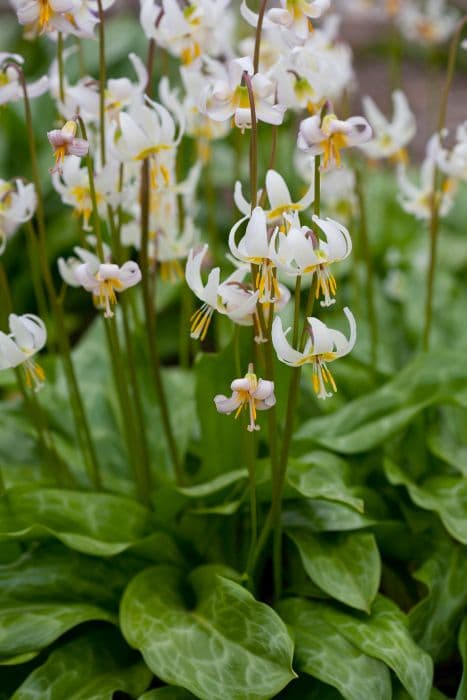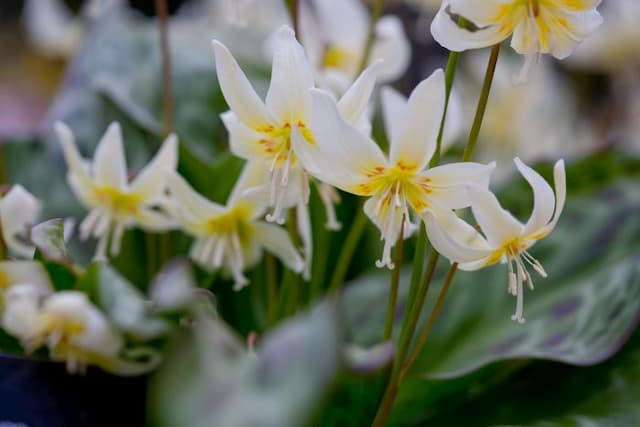Tulip 'Red Impression' Tulipa 'Red Impression' (PBR) (4)

ABOUT
'Red Impression' is a bulbous perennial to 60cm tall, with egg-shaped bright, deep red flowers in mid and late spring
About this plant
 Names
NamesFamily
Liliaceae.
Synonyms
Tulip, Red Impression Tulip.
Common names
Tulipa 'Red Impression' (PBR)
 Characteristics
CharacteristicsLife cycle
Perennials
Foliage type
Deciduous
Color of leaves
Green
Flower color
Red
Height
1-2 feet (30-60 cm)
Spread
0-1 feet (0-30 cm)
Plant type
Bulb
Hardiness zones
3
Native area
Central Asia
Benefits
 General Benefits
General Benefits- Colorful Display: Tulipa 'Red Impression' showcases vibrant red flowers, adding a splash of color to gardens during their blooming season.
- Easy to Grow: They are known to be easy to cultivate, requiring minimal care once planted in suitable conditions.
- Attracts Pollinators: The flowers attract bees and other pollinators, which are essential for the health of gardens and the pollination of many other plants.
- Landscape Versatility: These tulips can be planted in a variety of landscape settings, including borders, beds, and containers.
- Seasonal Interest: Their spring blooming period helps to mark the change of seasons and is often associated with the onset of warmer weather.
- Cut Flower Use: Tulipa 'Red Impression' is a popular choice for cut flower arrangements due to its striking color and sturdy stems.
- Breeding Achievements: The "PBR" denotes Plant Breeders' Rights, indicating that this variety has been recognized for its unique characteristics.
 Medical Properties
Medical PropertiesThis plant is not used for medical purposes.
 Air-purifying Qualities
Air-purifying QualitiesThis plant is not specifically known for air purifying qualities.
 Other Uses
Other Uses- Dye production: The petals of the Tulip can be used to produce natural dyes for fabrics, offering a range of colors from soft yellows to deep reds depending on the part of the plant used and the mordant applied.
- Perfumery: The scent of Tulip blooms is mild, but with proper extraction methods, it can be captured for use in crafting subtle floral perfumes.
- Eco-friendly art supplies: Children can use Tulip petals as eco-friendly pigments for painting, teaching sustainability through art.
- Edible garnishes: Tulip petals are edible; they can add a splash of color to salads and desserts, though they should be used sparingly due to their strong flavor.
- Botanical illustration: The Tulip's vibrant color and classic form make it a popular subject for botanical artists and illustrators.
- Literary inspiration: The distinct look and history of Tulips can serve as inspiration for writers, particularly in poetry and romance genres.
- Photography subject: Tulips, with their vivid colors, make for an excellent subject for photographers, especially for macro photography enthusiasts.
- Plant-based crafts: The sturdy stems and distinct flower heads of Tulips can be used in crafting, for example, to create floral arrangements or wreaths.
- Wedding decor: Tulips can be utilized not only in bouquets but also as decorations for wedding venues, offering a symbol of love and spring's arrival.
- Mood enhancement: The bright and cheerful colors of the Tulip can be used in color therapy to help lift spirits and create a positive atmosphere in the home or workplace.
Interesting Facts
 Feng Shui
Feng ShuiThe Tulips are not used in Feng Shui practice.
 Zodiac Sign Compitability
Zodiac Sign CompitabilityThe Tulips are not used in astrology practice.
 Plant Symbolism
Plant Symbolism- Love and Romance: Red tulips, such as the Tulipa 'Red Impression', are traditionally associated with deep love and passion, making them a popular choice for romantic occasions like Valentine's Day and anniversaries.
- Perfect Love: The red tulip is said to symbolize "perfect love," as it embodies the ideal nature and emotion of true, undying love between partners.
- Declaration of Love: Giving someone a red tulip is often seen as a declaration of one's strong and everlasting love for the recipient.
- Strength and Power: The intense color of the Tulipa 'Red Impression' can also represent strength and power, which may relate to both emotional fortitude and the boldness of one's actions or convictions.
- Fame: In some cultures, red tulips are associated with fame and being noticed, which makes them suitable as a gift to someone who is about to embark on a new venture where they seek recognition.
 Water
WaterTulips, specifically the 'Red Impression' tulip, require moderate watering during their growing season. Water these bulbs deeply when the soil feels dry to the touch, about once a week, providing approximately 1 gallon of water per square foot every time you water. Ensure that the soil drains well as tulips dislike excessively wet conditions which can cause bulb rot. During the dormant season, after the foliage has died back, you can reduce watering considerably as the bulbs are resting and excess water can harm them.
 Light
LightTulips, such as the 'Red Impression' variety, thrive in full sun to partial shade. They perform best when they receive at least 6 hours of direct sunlight each day. Plant them in a spot that receives the morning sun, as it is less harsh than the afternoon sun, especially in hotter climates. Never place them in full shade, as this will hinder their ability to bloom effectively.
 Temperature
TemperatureThe 'Red Impression' tulip prefers temperate climates with cool springs that allow them to flourish. These tulips can survive winter chill and require a period of cold dormancy with temperatures ranging between 35 to 55 degrees Fahrenheit. The maximum temperature during their growth period should not exceed 70 degrees Fahrenheit frequently, as heat can negatively affect bloom quality and duration.
 Pruning
Pruning'Red Impression' tulips don't require pruning in the traditional sense; however, deadheading, the removal of spent flowers, can be beneficial. Once the flowers have faded, remove them to prevent seed production, which can reduce the vigor of the bulb. Leave the foliage intact until it has yellowed and withered, typically by late spring or early summer. This allows the tulip to photosynthesize and store energy for the next year's bloom.
 Cleaning
CleaningAs needed
 Soil
SoilThe best soil mix for the Red Impression Tulip is one that is well-draining with a neutral to slightly acidic pH around 6.0 to 7.0. A mix of loamy garden soil with added sand or perlite and organic matter like compost is ideal to promote healthy growth and flower development.
 Repotting
RepottingRed Impression Tulips, being perennial bulbs, do not require frequent repotting. They should be planted outdoors and can remain in the same spot for several years as long as the soil is fertile and well-draining. It is only necessary to lift and divide the bulbs if they become overcrowded, typically every 3-5 years.
 Humidity & Misting
Humidity & MistingRed Impression Tulips are fairly adaptable to different humidity levels. However, they prefer average to low humidity conditions similar to those found in their native habitats. Excessive humidity can lead to fungal diseases, so it is ideal to provide conditions that mimic their natural dry summer dormancy period.
 Suitable locations
Suitable locationsIndoor
Ensure bright light, cool temperatures, and plant in well-draining soil.
Outdoor
Plant in full sun to partial shade, fertile well-draining soil, in fall.
Hardiness zone
3-8 USDA
 Life cycle
Life cycleThe life of the 'Red Impression' tulip begins with the planting of a bulb in fall before the first frost. The bulb, which is a storehouse of energy, overwinters in the ground and roots begin to grow during this period. In early to mid-spring, the bulb sends up a shoot that emerges from the soil as temperatures rise, leading to the development of leaves and a single sturdy stem. By mid-spring, the stem gives way to a vibrant red flower that is the hallmark of this tulip variety. After blooming, the flower wilts and the plant enters a period of dormancy by late spring or early summer; during this time, the foliage dies back and the bulb conserves energy for the next growing season. The bulb lies dormant through the summer, and the life cycle can repeat when the bulb is triggered again by falling temperatures in the subsequent autumn.
 Propogation
PropogationPropogation time
Spring
The Tulipa 'Red Impression', also known as the tulip 'Red Impression', is commonly propagated through bulb division. This process typically takes place in the fall, after the foliage has died back and the bulb is dormant. To propagate through bulb division, the existing bulbs are carefully dug up and the offsets, which are smaller bulbs attached to the main bulb, are gently separated. It's important to use a sharp knife to sever the offsets from the mother bulb if they do not come apart easily, ensuring minimal damage to both the parent and offspring bulbs. The newly separated bulbs should then be planted immediately at a depth approximately three times the height of the bulb, about 6 to 8 inches (15 to 20 centimeters) apart in well-draining soil. By the following spring, these bulbs will have established themselves and should produce their own flowers.








